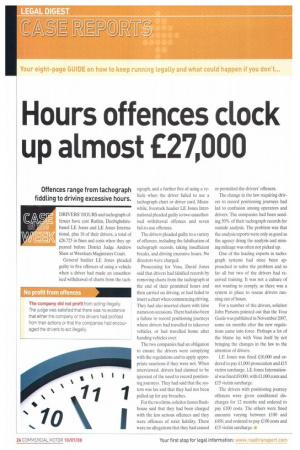Hours offences clock up almost £27,000
Page 26

If you've noticed an error in this article please click here to report it so we can fix it.
Offences range from tachograph fiddling to driving excessive hours.
DRIVERS' HOURS and tachograph offences have cost Ruthin, Denbighshirebased LE Jones and LE Jones InternaWEEK tional, plus 18 of their drivers, a total of £26,725 in fines and costs when they appeared before District Judge Andrew Shaw at Wrexham Magistrates Court.
General haulier LE Jones pleaded guilty to five offences of using a vehicle when a driver had made an unauthorised withdrawal of charts from the tach
No profit from offences
The company did not profit from acting illegally. The judge was satisfied that there was no evidence that either the company or the drivers had profited from their actions or that the companies had encouraged the drmers to act illegally. °graph, and a further five of using a vehicle when the driver failed to use a tachograph chart or driver card. Meanwhile, livestock haulier LE Jones International pleaded guilty to two unauthorised withdrawal offences and seven fail-to-use offences.
The drivers pleaded guilty to a variety of offences, including the falsification of tachograph records, taking insufficient breaks, and driving excessive hours. No directors were charged.
Prosecuting for Vosa, David Jones said that drivers had falsified records by removing charts from the tachograph at the end of their permitted hours and then carried on driving, or had failed to insert a chart when commencing driving. They had also inserted charts with false names on occasions. There had also been a failure to record positioning journeys where drivers had travelled to takeover vehicles, or had travelled home after handing vehicles over.
The two companies had an obligation to ensure the drivers were complying with the regulations and to apply appropriate sanctions if they were not. When interviewed, drivers had claimed to be ignorant of the need to record positioning journeys. They had said that the system was lax and that they had not been pulled up for any breaches.
For the two firms, solicitor James Backhouse said that they had been charged with the less serious offences and they were offences of strict liability. There were no allegations that they had caused or permitted the drivers' offences.
The change in the law requiring drivers to record positioning journeys had led to confusion among operators and drivers. The companies had been sending 50% of their tachograph records for outside analysis. The problem was that the analysis reports were only as good as the agency doing the analysis and missing mileage was often not picked up.
One of the leading experts in tachograph systems had since been approached to solve the problem and so far all but two of the drivers had received training. It was not a culture of not wanting to comply, as there was a system in place to rescue drivers running out of hours.
For a number of the drivers, solicitor John Parsons pointed out that the Vasa Guide was published in November 2007, some six months after the new regulations came into force. Perhaps a lot of the blame lay with Vosa itself by not bringing the changes in the law to the attention of drivers.
LE Jones was fined £10,000 and ordered to pay £1,000 prosecution and £15 victim surcharge. LE Jones International was fined £9,000, with £1,000 costs and £15 victim surcharge.
The drivers with positioning journey offences were given conditional discharges for 12 months and ordered to pay £100 costs. The others were fined amounts varying between £100 and £450, and ordered to pay £100 costs and £15 victim surcharge. ri








































































































































































